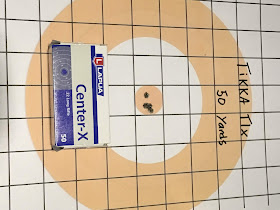I recently purchased a Tikka T1x and here is a real fast first impression of this riffle.
Things I like:
1. Overall fit and finish is excellent.
2. The polymer stock is solid and sturdy. Not flimsy in any way. Excellent if you like the all weather capability of a polymer stock.
3. The receiver has the same inlet pattern as its big brother the T3x. So you can use the same stock for both rifles.
4. 10 round detachable magazine.
5. medium weight barrel with threaded muzzle for your favorite muzzle device.
6. Trigger is amazing for a factory trigger. User adjustable from 2.5 Lbs - 5 Lbs. Single stage which means no slack, no creep, just a clean, crisp break. For a mass produced factory trigger it is one of the best.
7. Accuracy is excellent. Using quality ammunition you can get near one hole groups at 25 and 50 yards. Decent accuracy at 100 yards is also attainable. The Tikka would be a viable candidate as a 22 trainer for your long range, precision rifle. (this is what I'm using it for).
8. Bolt throw is only 45 degrees. So plenty of room to mount any scope you want.
Things I don't like:
1. A little pricey. In my area it retails for $470. More than your average 22. But I do think you get good value for your dollars.
2. Standard 11mm dovetail for scope rings. This is a European standard but less common here in America. I would like to see the factory put on a standard 1913 Picatinny rail. (Good news is, there are aftermarket options available)
3. The magazine protrudes down below the stock. I would like to have a flush mounted magazine like the old Ruger 77/22 rifles. This is mostly a preference than a true negative.
4. The polymer stock could use more checkering. It is slick where there is no checkering.
5. The stock has no provision for an elevated cheek rest when mounting a scope. You need to add an aftermarket pad to get a good cheek weld to the stock. Or buy an aftermarket stock.
6. No option for iron sights. Though iron sights are going the way of the Dodo bird, it would be nice to have them as an option.
Final Thoughts:
Would I buy this rifle again? Yes! Though a little on the expensive side for a 22, I think you get good value for your dollars. I see the quality good enough you can pass this down to your children and even grandchildren.
If you are looking for a good general purpose target rifle or a hunting rifle, this is an excellent choice. If you want to build a 22 trainer to match your Tikka T3x, again, this is an excellent choice.
Yes, I do like this rifle. I'll do a more detailed review later once I have more trigger time with it and make desired upgrades.
Now enjoy some photos of my latest outing with the rifle.
By:
Mez
April 2019
Stock rifle:
Scope: SWFA fixed 10 power
Shoots well with several brands of 22
At 100 yards, I think this rifle is capable of better groups. I have shot smaller groups in the past.
I will experiment with other brands of ammunition and practice more to verify.
I'll also weasel a bit and say the indoor ventilation was running on high and might have caused a few shots to drift.









